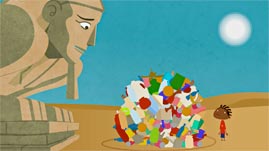Teachers' Domain - Digital Media for the Classroom and Professional Development
User: Preview


Source: LOOP SCOOPS



Major funding for LOOP SCOOPS is provided by the Corporation for Public Broadcasting and the U.S. Environmental Protection Agency.
Although the information in these materials has been funded in part by the U.S. Environmental Protection Agency under assistance agreement 83447601 to WGBH, it may not necessarily reflect the views of the Agency and no official endorsement should be inferred.
In this animated video from LOOP SCOOPS, a sphinx gives a boy named Oliver a week's worth of garbage and asks him to make it smaller. Oliver removes glass, cans, paper, and plastic for recycling; food scraps for composting; and clothes and toys for donating. He is then surprised to learn that the garbage was his own, and learns the importance of "less chucking, more recycling."
Municipal solid waste (MSW) is the stuff that most of us know as garbage: the coffee grounds, banana peels, packaging, yard trimmings, magazines, newspapers, and other waste that is collected from homes and businesses. Even though people are recycling more than ever, each person in the United States still generates about 4.5 pounds of MSW per day, according to the Environmental Protection Agency (EPA). For the whole United States, this adds up to about 254 million tons of MSW every year.
Preventing waste before it is generated—a practice called source reduction—can save money, energy, and natural resources, and also reduce pollution. When corporations make a small change in their packaging, it can make a huge difference. For instance, when McDonald's reduced its napkin size by 1 inch, the company prevented 12 million pounds of paper from being thrown away each year. And when they switched to lighter-weight packaging for two of their sandwiches, they conserved 3,200 tons of boxboard containers.
There are many ways consumers can practice source reduction, as well: avoid products with excessive packaging; buy used items; buy items in bulk rather than multiple, smaller packages; reuse bags and containers; and donate used clothes, toys, and games instead of throwing them out.
Here are suggested ways to engage students with this video and with activities related to this topic.
 Loading Standards
Loading Standards Teachers' Domain is proud to be a Pathways portal to the National Science Digital Library.
Teachers' Domain is proud to be a Pathways portal to the National Science Digital Library.
